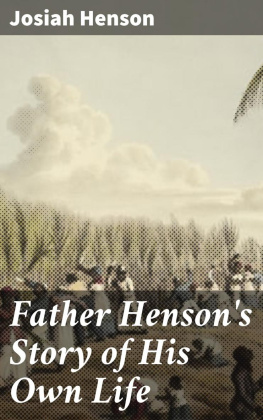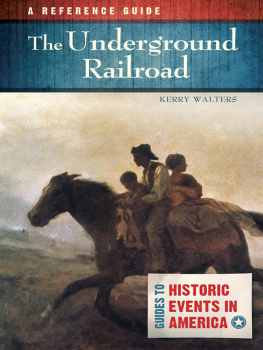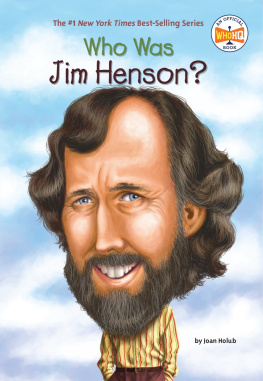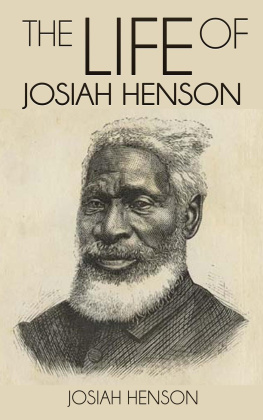Uncle Tom's Story of
His Life
An Autobiography of the Rev. Josiah Henson
(Mrs. Harriet Beecher Stowe's "Uncle Tom"). From
1789 to 1876. With a Preface by Mrs. Harriet Beecher
Stowe, and an Introductory Note by George Sturge,
and S. Morley, Esq., M. P.
By Josiah Henson
Edited by John Lobb
A DocSouth Books Edition
The University of North Carolina at Chapel Hill Library
Chapel Hill
About This Edition
This edition is made available under the imprint of DocSouth Books, a collaborative endeavor between the University of North Carolina at Chapel Hill Library and the University of North Carolina Press. Titles in DocSouth Books are drawn from the Library's "Documenting the American South" (DocSouth) digital publishing program, online at docsouth.unc.edu. These print and downloadable e-book editions have been prepared from the DocSouth electronic editions.
Both DocSouth and DocSouth Books present the transcribed content of historic books as they were originally published. Grammar, punctuation, spelling, and typographical errors are therefore preserved from the original editions. DocSouth Books are not intended to be facsimile editions, however. Details of typography and page layout in the original works have not been preserved in the transcription.
DocSouth Books editions incorporate two pagination schemas. First, standard page numbers reflecting the pagination of this edition appear at the top of each page for easy reference. Second, page numbers in brackets within the text (e.g., "[Page 9]") refer to the pagination of the original publication; online versions of the DocSouth works use this same original pagination. Page numbers shown in tables of contents and book indexes, when present, refer to the original works' printed page numbers and therefore correspond to the page numbers in brackets.
Summary
Josiah Henson was born into slavery on June 15, 1789, in Charles County, Maryland, on a farm belonging to Francis Newman. Henson's parents' names are unknown. Separated from his father and siblings in early childhood, Henson was raised by his mother on the farm of Isaac Riley in Montgomery County, Maryland. As a young man, he became the superintendent of Riley's farm. He was attacked by a neighboring overseer at age nineteen or twenty and for the rest of his life was unable to lift his arms above his head. At age twenty-two, he married an enslaved woman from a neighboring plantation, whose name was Charlotte; the couple had twelve children. Riley transferred his slaves to his brother's plantation in Kentucky in 1825, and Henson lived there until he attempted to purchase his freedom in 1828. He was swindled out of $350 by his master and barely escaped being sold into New Orleans. Henson and his family escaped to Canada in 1830, and in 1838, he helped to found the Dawn Settlement for fugitive slaves, which operated a manual labor school and a sawmill. Henson traveled to England three times to raise money for the settlement, and he met Queen Victoria in 1877. After his first wife's death, Henson married Nancy Gamble, a widowed free black woman, in 1856. He died in Dresden, Ontario, on May 5, 1883. Part of the lands of the Dawn Settlement are now a historic site operated by the Ontario Heritage Trust and include the Henson family's home.
This 1876 version of Henson's autobiography is the first of many editions issued by British editor John Lobb. It followed the original 1849 edition and a much-expanded 1858 version, both published in Boston, as well as at least two other lesser-known reprints. Called "almost entirely the work of John Lobb" by historian Robin Winks, this version nevertheless is similar in phrasing to the American edition of 1858, up through the twenty-third chapter (xxiii). Its most significant change is to the title page, which specifies that Henson is the Uncle Tom of Harriet Beecher Stowe's novel. Lobb made this claim enthusiastically in all his editions of Henson's autobiography, but Stowe herself stressed that her novel was "not the biography of any one man" (Winks, Blacks in Canada 193). A preface written by Stowe and first published in the 1858 version is reprinted here.
The basic story of Henson's life in Uncle Tom's Story of His Life is similar to the version given in The Life of Josiah Henson. Henson is born on the farm of Francis Newman, to whom his mother had been hired out and to whom his father was enslaved. Henson's first significant memory is of his father returning home "with his head bloody"in fact his ear severed"and his back lacerated," having been whipped severely for defending his wife from a white overseer's rape attempt (p. 14). When his father is sold and taken to Alabama, his mother's master, Dr. Josiah McPherson, reclaims her and her six children. McPherson dies two or three years later, and his slaves are sold. Henson and his mother are briefly separated, but after he nearly dies, his new master "sell[s]... him cheap" to Isaac Riley, the man who has bought his mother (p. 14). Henson grows up on Riley's farm.
Strong and intelligent, he becomes a favorite of Riley's and during his teen years is made superintendent of the farm, "practically overseer" (p. 23). He raises crop production to "more than double" and works long days overseeing the farm and taking its produce to market (p. 23). At eighteen, Henson experiences a conversion to Christianity and becomes a preacher among the slaves in his area. At age nineteen or twenty, Henson is badly injured when a neighboring overseer attacks him. From the time of this beating on, Henson cannot raise his arms above shoulder level. At age twenty-two, Henson marries a woman named Charlotte, a slave from a neighboring farm. They have twelve children, eight of whom survive.
In 1825, a lawsuit against Isaac Riley causes him to fear losing his slaves (p. 42). He gives Henson a pass to conduct all of the slaves to his brother's plantation in Kentucky. The group passes the Ohio shore by boat during the journey and are told by onlookers that they are "no longer slaves, but free men, if [they] chose to be so" (p. 51). Henson's "notions of right" are against running away, and he looks forward to the "immense admiration and respect" with which Amos Riley will regard him when he arrives in Kentucky with the entire group of slaves (p. 52). He commands the group to keep going. Henson waits in Kentucky for three years for his master to arrive and becomes superintendent of Amos Riley's plantation. During this period he is also admitted as a preacher by the Methodist Episcopal Church.
In 1828, Henson hears that Isaac Riley will remain in Maryland and has decided to sell all his slaves other than Henson and his family. Henson says that his "eyes [are] opened" to the "guilty madness" of having earlier prevented the same people from acquiring freedom (p. 60). He asks permission to travel to Maryland to visit Isaac Riley. On the way he preaches in Ohio and gathers donations, and when he reaches Maryland, negotiates to purchase his freedom. Isaac Riley agrees, accepts a large down payment, and sends Henson back to Kentucky. However, he tells his brother that the remainder of the payment is $650 rather than the agreed-upon $100. Neither brother plans to allow Henson to work off the sum and, swindled and frustrated, he returns to his normal labors.









